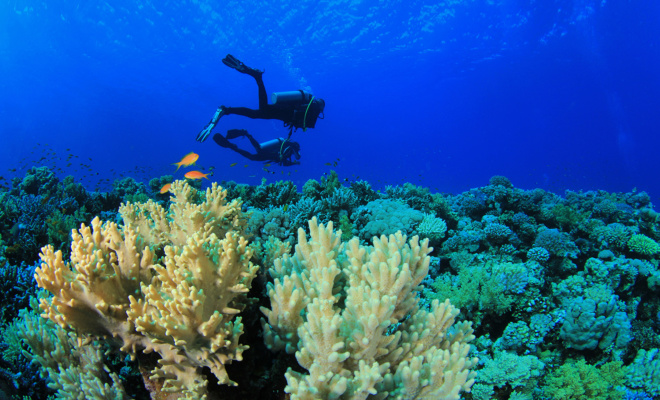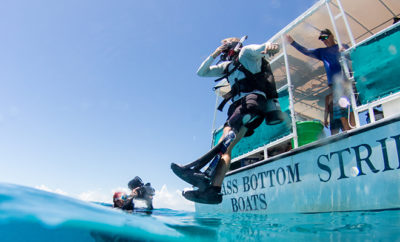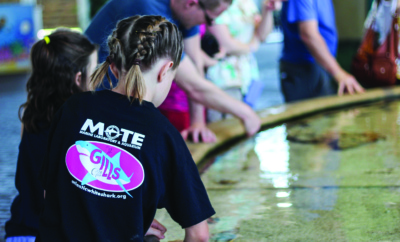
Feature
Mote’s Next-Generation Scientists
Bright Minds Shed Light on Protecting Earth’s Oceans
By Sue Cullen
One of the key pillars of Mote Marine Laboratory’s vision for its future is securing the next generation of marine scientists dedicated to responsible stewardship of the world’s oceans. Supporting these young scientists is a major goal of Mote’s 2020 Vision and Strategic Plan and is key to helping protect ocean habitats and sustain fisheries of vital importance both worldwide and much closer to home.
“At Mote, we continue to strengthen our focus on the next generation of world-class scientists who are finding solutions to the grand challenges facing our oceans today,” said Dr. Michael P. Crosby, Mote President and CEO. “Our Mote Postdoctoral Research Fellowship Program is an innovative initiative to recruit, nurture and keep the next generation of the best and brightest minds in marine science, and it is funded entirely through philanthropy.”
ACHIEVING ANOTHER 2020 GOAL
Already these bright minds are finding ways to support native fisheries and save the world’s coral reefs from disease and the stresses of climate change. The work of four of these marine scientists highlights the profound worldwide effects possible if they can help Mote achieve another 2020 goal, which is to ensure its science and technology make a positive impact on society and the environment. Three of these young scientists are in Mote’s postdoctoral research program.
It is no exaggeration to say as the oceans go, so goes the world. Three billion people worldwide rely on seafood as their primary source of protein, according to the World Wildlife Fund, and as populations rise, so will demand. The impact on Florida’s economic health is also substantial. National Oceanic and Atmospheric Administration Fisheries data shows the economic impact in Florida of commercial and recreational fishing in the Gulf of Mexico alone to be $25.8 billion in sales, 172,000 jobs, and $11 billion in value added impacts.
SCIENTISTS SAVING SNOOK
Mote postdoctoral scientist Dr. Ryan Schloesser’s main projects aim to make an impact on snook, a key fishery that is under stress. Schloesser’s work is important because snook populations have been drastically reduced by two extreme cold events in 2001 and 2010 and by red tide. Commercial snook fishing is prohibited and recreational fishing is strictly limited. He wants to understand the habitat preferences of juvenile snook and determine how to restore depleted snook populations responsibly.
“We use passive integrated transponder tags to monitor the habitat use of the juvenile fish we release in Phillippi Creek to determine what are quality habitats for this recreationally and commercially important fish,” he says. “We use the latest technology available to get all the information we can to improve release strategies and develop responsible guidelines.” Eight arrays set up along Phillippi Creek identify where juvenile fish prefer to spend their time, comparing natural shoreline with mangrove and marsh habitat, clear areas of seawall, and seawall with aquatic plants.
“We are using these juvenile fish as an ecological probe to find what habitat is used most commonly so we can support that,” Schloesser says. “One of the key findings is that vegetation with shoreline, hardened or not, provides the best survival. If people are concerned about the impact of coastal development and wonder what they can do, promoting vegetation along hardened shorelines can help.”
OCEAN ACIDIFICATION AND CLIMATE CHANGE
Another postdoctoral scientist, Dr. Philip Gravinese, is studying the effects of climate change, ocean acidification and low oxygen levels on another crucial Florida fishery–stone crabs. Gravinese’s doctoral work focused on how stone crab larvae are affected by climate change, which elevates ocean temperatures and increases acidification because more atmospheric carbon dioxide is absorbed into seawater. His work with Mote builds on that by looking at how those stressors impact post-larval and juvenile stone crabs.
“Fishermen are interested because they are seeing changes; less catch and they know temperatures are going up. We should be able to shed some light on what will be impacting future yields,” Gravinese says. “The ultimate goal is to identify the tolerances of the different life stages to these changing variables and find ways that reduce the impact of some of these stressors. That might give stone crabs better chances and the opportunity for stability in the future.”
RESTORING CORAL REEFS
Dr. Erinn Muller, who was hired as the first Mote Postdoctoral Fellow in 2011, is now a Staff Scientist and Coral Health and Disease Research Program Manager, and has received two National Science Foundation grants that support her work to understand coral health and responses to disease. One five-year grant of more than $575,000 allows Muller to study the effects of major environmental stressors on threatened staghorn coral such as disease, high water temperatures and ocean acidification. She focuses on genetic varieties that may be more resistant to, or more able to recover from, those stressors.
The second grant is aimed at better predicting how corals react to disease exposure and how that will influence the coral community of the future. The study is based on immune response and disease resistance and will quantify how susceptible coral species are to disease by examining their immunity through a series of novel experiments and approaches.
“Reefs are worth $6 billion to Florida’s economy.”
Muller’s work builds upon the game-changing discovery at Mote’s Center for Coral Reef Research and Restoration on Summerland Key that coral can be repopulated more quickly than thought possible by a process of micro-fragmentation and re-skinning. To further that work, the lab is home to about 60 different coral genotypes. “I see how these different strains respond to major stressors that they will continue to be affected by in the future, which are high water temperature, global climate changes, diseases and ocean acidification,” she says. Understanding which genotypes better survive changing conditions will help scientists worldwide restore coral reefs more effectively.
“If we lose coral reefs, we lose the biodiversity of our ocean environment. Reefs protect shorelines and are a great source of new pharmaceuticals to fight antibiotic resistant bacteria, and they impact our economy as well. Reefs are worth $6 billion to Florida’s economy and support 70,000 jobs,” Muller says. “We need to take bold steps in research and restoration to be sure we have coral reefs 10 years from now.”
STUDYING COMPLEX RELATIONSHIPS
Postdoctoral scientist Dr. Rob Nowicki studies the intricate relationships at play between the living creatures and the environment within an ecosystem. “My focus is what happens when you lose it all, and my research is on what makes a system resilient when bad things happen,” Nowicki says. “That fits with Mote’s focus on restoring coral because we want to make sure the biological interactions of healthy reefs are there.”
Nowicki currently is setting up a study to determine the impact of “halos” of bare sand separating reefs from seagrass beds where many reef fish spawn. He aims to discover whether these barren stretches present barriers to returning to the reef where many of these fish perform important functions such as eating algae that can outcompete coral. Nowicki is establishing artificial seagrass corridors across bare patches to determine whether – by offering them shelter from predators – more fish will return to the reef.
“The big picture goal is to get reefs back to how they looked in the 1960s before everything started to look terrible. If we find reef connectivity is important, it means maybe we should choose reefs that are already connected to restore. It adds a restoration tool to our toolkit,” Nowicki says. “Even if not, it’s still important because we’ll know it’s not a factor in deciding where to restore corals.”
One thing is clear. With dedication, devotion and enthusiasm for their work, these young marine scientists are already making significant contributions to their field, to the local area, and to the world.






You must be logged in to post a comment Login